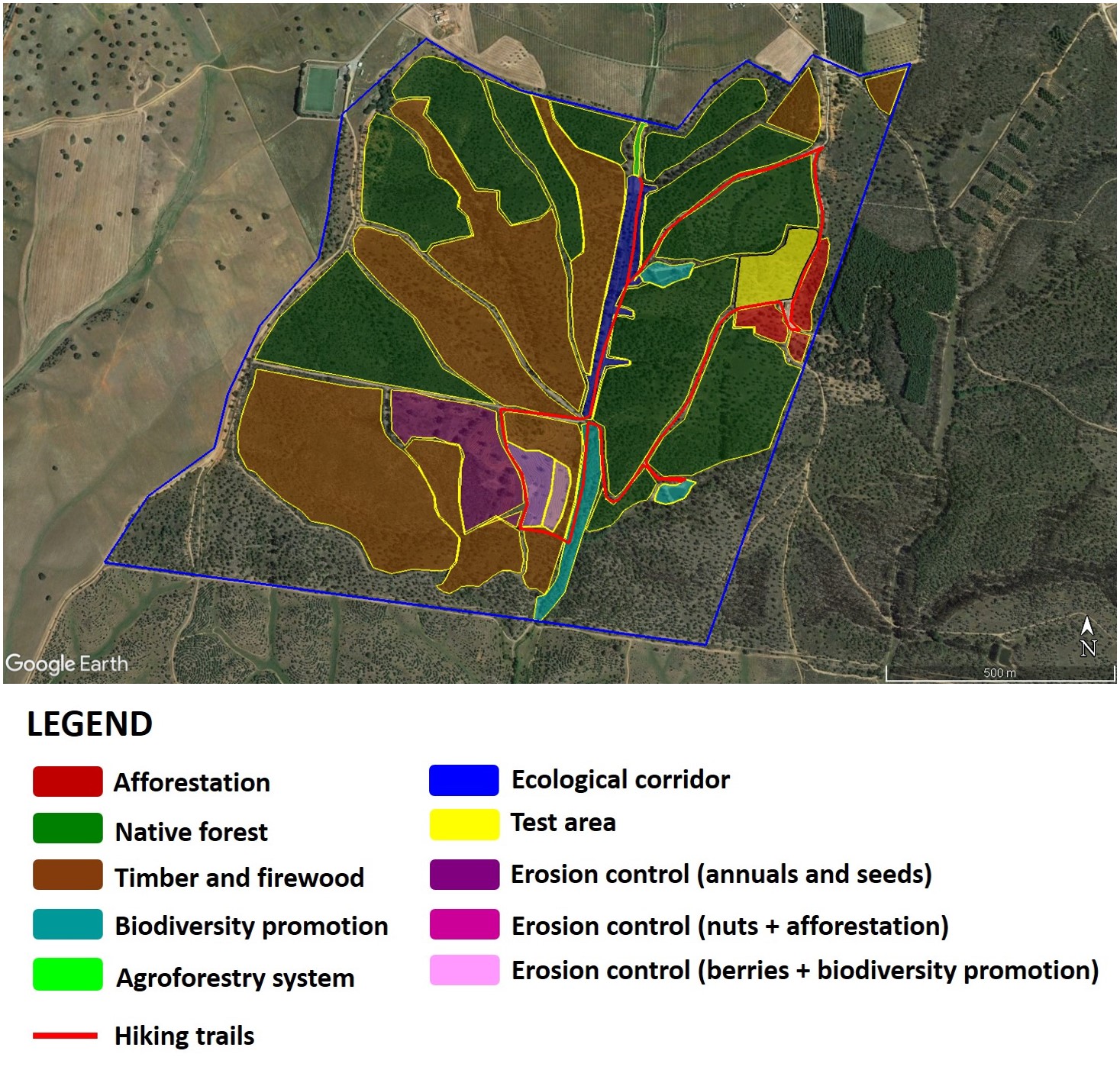|
|
L8 Cab Gor: FREGUESIA DE CABEÇA GORDA (PT) |
||||||
|
|
|||||||
|
FUNCTIONS APPLIED TO THE LAND |
|||||||
|
ECONOMIC |
|||||||
|
Aromatics [1] |
Herbs and aromatics (Rosmary, lavander, asparagus, fennel) will be interplanted with other vegetation in most functions, with focus on the orchard in the agroforestry system. Products will be used for village kitchen and/or sold in local market. |
||||||
|
Annuals and seeds [2] |
Seed mix (Avena sativa Avena strigosa, Triticosecale Wittmack, Lolium multiflorum, Lolium multiflorum var. westerwoldicum, Vicia sativa and Pisum sativum) was sown through out functions, wherever bare soil is found. |
||||||
| Fruits [7] |
Orchards in agroforestry system (interplanted with forest species, nitrogen fixing perennials and aromatics, with different strata combined). Evergreen species of different strata used has windbreak. See function 24 Food garden for self-sufficiency. |
||||||
|
Nuts [15] |
As part of erosion control function. Pine, almond and carob trees were planted. Nuts, will be used for village kitchen and sold to local market. | ||||||
|
Mushrooms [12] |
This function focus on best practices for managing the land in order to potentiate the presence of commercially viable mushrooms (no-till, soil cover, reforestation, etc). Every year the Silarca Mushroom Festival takes place in Cabeça Gorda (SILARCA Festival do Cogumelo). |
||||||
|
Natural fibers [13] |
Cork oak interplanted in the areas dedicated to restoration of native forest is used for the production of natural fibers. |
||||||
| Berries [18] |
As part of other functions, i.e. food garden and erosion control areas. |
||||||
|
Timber, firewood and biomass [19] |
This is a coppice system of eucalyptus for the production of timber firewood and biomass. Areas with the highest natural regeneration of Quercus sp were selected for thinning Eucalyptus. |
||||||
|
Pasture improvement [20] |
Pasture improvement is carried out throughout other functions using a mix of grasses and legumes. |
||||||
|
ECOSERVICES |
|||||||
|
Bee keeping rights [22] |
Apiaries are in place, rights paid in honey used for village kitchen. | ||||||
|
Food garden for self-sufficiency [24] |
Fruits (i.e. Japanese and European plum, apricot, peach, pear) vegetables (selected year-by-year depending on market), berries (i.e. raspberry, red currant, blueberries) and aromatics (i.e. rosemary, thyme, sage) are planted as a food forest-like system. Interplanting is used to make the most use of the space. The idea is to produce everything is needed to village kitchen to become self-supporting, starting a circular economy. |
||||||
| Hiking trails [27] |
Some trails are already present, they will be only repaired and the trail marks added. |
||||||
|
Test Area [32] |
In this area several growing aids were tested: cocoons, stones, wood chips and compost. |
||||||
|
ENVIRONMENTAL |
|||||||
|
Erosion control [37] |
Swales were made to improve water infiltration and avoids soil erosion. Bare soil was firstly cover with seeds mix. Reforestation focus on the use of multiple species for multiple purposes (nuts, wild berries/fruits, shade, protection, nitrogen fixing, food and shelter for disperser animal species, seed pool, genetic diversity). Tree varieties better adaptive to drought and climate change were selected. Retama sphaerocarpa was used as nurse shrubs. |
||||||
| Wildlife protection [39] |
As part of other functions. | ||||||
|
Insect shelter [40] |
Dead wood in swales to provide shelter for arthropods, reptiles and amphibians. | ||||||
| Native forest and afforestation [41] |
“Natural forest” areas focus on the identification and protection (when feasible) of natural regeneration. Selective cleaning with shrub cutter was done. The afforestation areas focus on the reforestation with multiple species for multiple purposes (nuts, wild berries/fruits, shade, protection, nitrogen fixing, food and shelter for disperser animal species, seed pool, genetic diversity). |
||||||
|
Streambed protection [42] |
Shrubs (common hawthorn, myrtle, mock privet) and trees (arbutus, common ash, elder) are placed around stream where this is not covered with vegetation and shadow. Biodiversity promoting species were selected. |
||||||
|
Ecological Corridor [43] |
The recovery of vegetation along the stream and the selection of plants that support biodiversity create a wildlife refuge as well as a buffer zones. | ||||||
|
Biodiversity promoting plants [46] |
Increase plant biodiversity in protected areas to support insects, birds and mammals biodiversity. | ||||||
|
SOCIAL |
|||||||
| Create employment
[47] |
Several implemented functions will require hiring, namely a full-time employee and several seasonal employees according to the needs. |
||||||
| Work with disabled people [48] |
No specific action will be put in place. it's a park, it happens to work with disable people. |
||||||
|
Provide social services [49] |
The food garden provides products for social canteen. | ||||||
| MEASURES APPLIED TO THE LAND | |||||||
| N. | Name | Comments | |||||
| 1 | Seed collection |
Oak acorns used for reforestation. |
|||||
| 3 | Existing vegetation |
Transplantation of small trees, using dead and live eucalyptus trunks to build stork nests and poles, chipping other woody vegetation to improve organic matter. |
|||||
| 4 | Mycorrhizae & plants |
Mycorrhizae used to produce edible mushrooms to use in social kitchen and sold during the Silarca Mushroom Festival. |
|||||
| 7 | Swales |
Swales were made to improve water infiltrationa and reduce soil erosion. |
|||||
| 9 | Half-moons |
Common practice. Half-moons were done on slops and "full moons" in the flatter areas. |
|||||
| 10 | Soil ripping |
Done only when necessary in conjunction with ridge and furrows. |
|||||
| 11 | Conservation tillage | Everywhere no tillage, just superficial tillage or cutting. | |||||
| 12 | Ridge and furrows | Done only when necessary in conjunction with soil ripping | |||||
| 13 | Capture & Store Water |
Existing ponds are implemented in order to increase the amount of available water for wildlife throughout the year and increase their quality. |
|||||
| 14 | Organic fertilizer |
Compost is added. |
|||||
| 15 | Pasture improvement |
Improving pasture resilience by introducing additional species (legumes). |
|||||
| 17 | Legumes |
They were used in mix with grasses to cover soil and improve pastures. |
|||||
| 19 | Nurse shrubs |
Retama sphaerocarpa is used as nurse shrubs. |
|||||
| 21 | Plant hole digging |
Selective digging of holes to avoid large-scale soil disturbance. |
|||||
| 22 | Interplanting |
Such techniques is used to make the most use of the space. |
|||||
| 23 | Planting in mixes |
Used to implement biodiversity at all levels. |
|||||
| 25 | Natural fence |
Multi-purpose natural fence to protect crops and provide food, fodder and shelter for biodiversity. |
|||||
| 26 | Plant support Water aids study |
The cocoons method was tested but did not produce optimal results on this kind of soil (thin, clayey and rich in rock fragments). |
|||||
| 27 | Watering/Drip irrigation |
Introducing drip irrigation/watering to save water. |
|||||
| 28 | Plant protectors |
Tubex protectors are used. |
|||||
| 29 | Plant assist |
Cocoons, compost, straw mulch and stone mulch. |
|||||
| 30 | Fencing installation |
Wildlife feeding places, food garden and ponds are fenced. |
|||||
| 32 | Diseased trees |
Re-planting is foreseen using local seeds. |
|||||
| 33 | Weed control |
Only cutting or grazing, no chemicals and weeding. |
|||||
| 34 | IPM Plague control |
Developing an Integrated Pest Management (IPM), to carry out insect & plague control on eco-friendly way. Providing shelter/host plants for predator insects. |
|||||
| 35 | Pruning |
Using pruning in an optimal way. Stacking the prunings in rows to collect water and improve biodiversity |
|||||
| 38 | Ecoservices |
The implementing of existing trails will bring further values and incomes. |
|||||
| 42 | Biofules |
When available will be used. |
|||||
| 43 | Planting on ridges | ||||||
| 44 | Firewood 10% rule |
0% of the dead wood is always left on the site |
|||||
| 47 | Aquatic filters |
Planting special aquatic filtering plants |
|||||
| 48 | Shadow trees |
Some fruit species like apples and pears can be damaged by too much sun. Planting shadow trees in between the fruits. |
|||||
| 51 | Planting material | ||||||
| 52 | Root protection |
No machine or soil work around each tree. |
|||||
|
Numbers of functions and measures correspond to the list reported in the DAM methodology, defining the operative DAM plan http://www.desert-adapt.it/index.php/en/case-studies/dam-methodology |
|||||||
| FIELD IMPLEMENTATION OF THE DAM PLAN | |||||||
|
Testing plant growth aid techniques to support seedlings establishment and growth [Adaptation Measures: plant support & water aid 26 - plant protectors 28 - plant assist 29] In municipality of CABEÇA GORDA water aids to improve the seedling survival rates in the first years after planting under harsh environmental conditions, were tested. Specifically, cocoons were installed (Pict. 1-2) and tested but did not produce optimal results due to the physical features of such soils (thin, clayey and rich in rock fragments). A low cost nature-based solutions relying on material present in the study area like rock (Pict. 3-4) was used to improve the soil water retention. Other seedlings were traditionally planted by adding compost in the hole planting to improve organic carbon content and water retention too (Pict. 5-9). |
|||||||
|
|||||||
|
Pasture improvement [Economic function: 20] Pasture improvement is carried out in all project plots using a mix of grasses and legumes to increase soil organic carbon content, reduce soil erosion by keeping the soil surface covered and providing food for pollinators. Picture 1 and 2 show two sequential stages of pasture growth. |
|||||||
|
|
|||||||
|
Erosion control [Environmental function: 37] Swales were made in areas at high erosion risk to reduce surface runoff and soil loss. |
|||||||
|
|
|||||||







